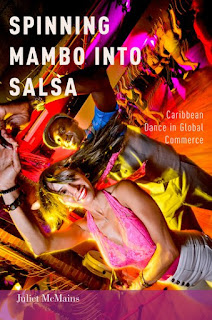The past five years has seen an increasing amount of literature published, in book format, concerned with the ethnography and sociology of popular Latin dance, whose primary target audience includes the interested non-Academic. I find this a welcome and much needed development, redressing the imbalance between the study of Latin music, which is richly explored, and of Latin dance, which has lagged behind. McMains' contribution has gone a long way into redressing that with respect to salsa, and may soon be regarded as a seminal work.
Through a combination of fieldwork, personal interviews, literature review, and secondary sources such as interview transcripts and internet videos, Juliet brings together a broad detailed tapestry of life in the mambo and salsa lane woven with compelling arguments. She is true to the realm of academic study, dispelling lore and revealing reconstructed histories, as she addresses polarising issues which continue to divide our salsa communities:
- the on-1 versus on-2 rhythm debate;
- mambo authenticities;
- European versus African aesthetics;
- salsa of the North versus salsa of the South, and
- what it means to be a dancer in the modern era of internationalised Latin dance.
Compelling though it is, there are some instances where her opinions and mine differ.
I would have liked to hear an Africanist voice in the rhythm debate; "on-1 versus on-2" dissolves in the face of how African percussionists perceive the rhythm-cycle, as does the significance of beat 2.
The exploration of son cubano on eastern Cuba (performed in an individual circular style also called 'rueda') was a glaring omission, one which I think weakened her conclusions across contratiempo and modern Cuban dance.
Her observations come across as drawn from the rarefied atmosphere of the elite dancer. Whilst I might agree with her conclusions on the prevalence of styles and dispositions, drawn from congress and workshop experience, I find that this differs greatly from what is happening at the international grassroots level of dancers taking their early steps at bars and clubs worldwide.
The African aesthetic, so well introduced early on, was a fading thread such that it had disappeared before the end. Opportunities were missed where its presence would have made a valuable contribution, for example in the re-working/re-imagining of African authenticities on congress performance.
The link between dance and music was underdeveloped, and allowed to be imbalanced with its focus on beat 1 and 2. For example I would have liked to hear her thoughts on salsa's matancerisation with its cumbia-esque bass-line and whether it had a relationship with on-3; or why beat 2 became the 'gold standard' over that of the ponché or beat 4.
There are weaknesses in the book: the kineschizoponia; the thready African perspective; the mono-cultural perspective drawn from elite dancers; the mis-pitching of the tagline "Caribbean Dance in Global Commerce" when it hardly addresses Europe nor Asia.
"Spinning Mambo Into Salsa" is a labour of love by an exceptional researcher who is a lover of dance. It is a fascinating insight into the salsa world of North America. It is a candle of truth to illuminate the salsa/mambo lore which has been constructed for commercial objectives. It is a gateway to the burgeoning field of dance sociology.ethnography. It is essential reading for anyone who loves salsa as much as Juliet McMains does. As I do.
Loo Yeo

No comments:
Post a Comment